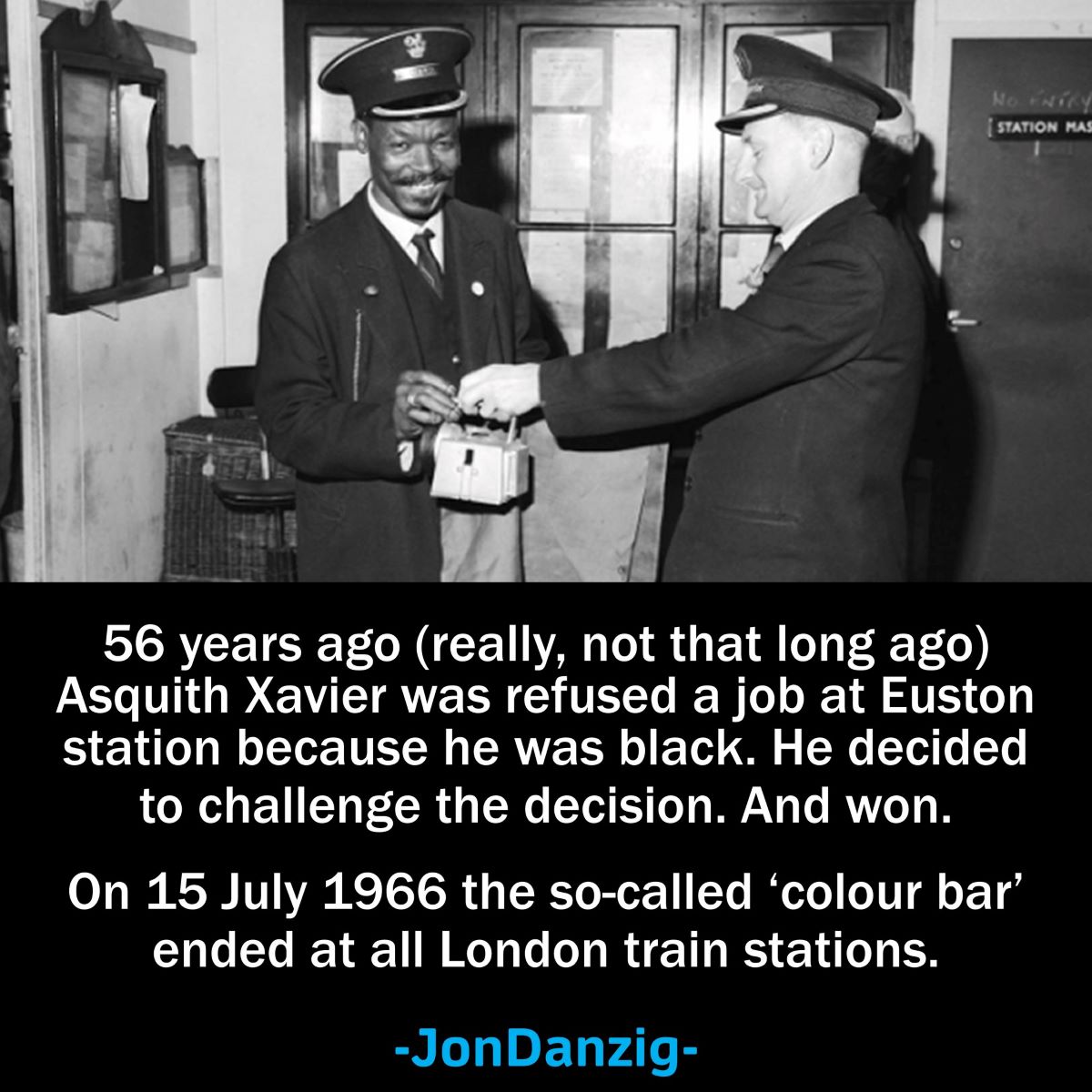
Invited to come to Britain in the 1950s, when the country was massively short of workers (sound familiar?), Asquith Xavier left Dominica where he had been a police officer and in the army.
For ten years, he worked as a porter at Marylebone station in London. Then, in the spring of 1966, the 46-year-old decided to apply for promotion as a guard at Euston station. But he received a letter from the local committee at Euston, stating that he could not be a guard as the station did not accept ‘coloured men’ in that post. (Yes, it was that blatant).
Unions and management had informally agreed in the 1950s to ban non-white people from jobs at Euston involving contact with the public; they could be cleaners and labourers, but not guards or ticket collectors.
The Race Relations Act of 1965 had made discrimination on “grounds of colour, race, or ethnic or national origins” unlawful in public places in Great Britain (but not Northern Ireland). But Asquith could not use this legislation to support him, as it did not cover workplaces.
Colour bars were in place in many London train stations at the time.In 1957, some union members at Kings Cross station campaigned against “coloured workers”. But other union members opposed the discrimination.
In 1956, a BBC Panorama documentary revealed that the ‘colour bar’ at Euston was active.Asquith’s colleague in the National Union of Railwaymen (NUR), Jim Prendergast, alerted the press about what happened to him.
It was a pivotal moment in the history of race relations because it led to media interest, questions in Parliament, and eventually, changes.
On 15 July 1966 British Railways announced that colour bars at stations in London had been abandoned.
Asquith was offered the job with his pay backdated to May, the month when he had been originally rejected.
But he did not have an easy time in his new job. He received death threats and needed a police escort to work. In 1968, the new Race Relations Act outlawed racial discrimination in both work and housing. There is no doubt that Asquith’s brave actions helped to break the colour bar at London train stations. But really, 56 years later, has much changed? Yes, legislation has helped to outlaw racial discrimination, but all these years later, racism is still rampant in Britain.
The boss of MI5, Ken McCallum, has warned that ‘toxic racism’ is fuelling the rise of far-right terror in Britain.
Back in 1966, England’s World Cup winning team only had white players. Today, the England football team is more representative of the country’s population by including British black players.
But attacks on England’s black football players in the Euro 2020 final last year revealed shocking deep-seated racism.
Mr McCallum said that the abuse levelled at players Marcus Rashford, Jadon Sancho and Bukayo Saka for missing their spot kicks in the penalty shoot-out had exposed an “important thing for us all” that society needed to address.
“Racism is a toxic issue that MI5 confronts every day, most visibly in our work to deal with extreme right-wing terrorism,” he said.
“Racism is not the sole and only fuel of that threat, but it is strongly there.”
We need to root out all forms of racism. It is a poison that no modern, cosmopolitan country should allow to persist.
Racism, in great part, led to Brexit. Racism is a destroyer of sport. Racism is the fuel behind right-wing extremism. People are not born as racists. It is something that’s learnt. That is our one hope. Racism can, and must, be unlearnt.
Jon Danzig is a campaigning journalist and film maker who specialises in writing about health, human rights, and Europe. He is also founder of the pro-EU information campaign, Reasons2Rejoin. You can follow Jon Danzig on his Facebook journalism page at www.Facebook.com/JonDanzigWrites




